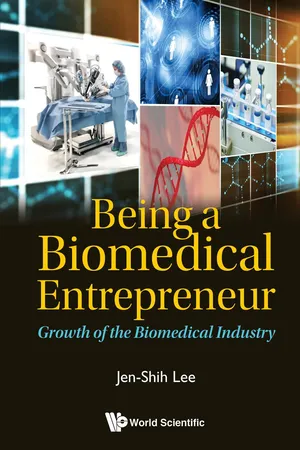Technology & Engineering
Biomedical Engineering
Biomedical engineering involves the application of engineering principles and design concepts to medicine and biology for healthcare purposes. It encompasses the development of medical devices, diagnostic equipment, and advanced therapies, as well as the integration of technology with the human body to improve healthcare outcomes. This interdisciplinary field combines expertise in engineering, biology, and medicine to address complex health challenges.
Written by Perlego with AI-assistance
Related key terms
2 Key excerpts on "Biomedical Engineering"
- eBook - ePub
Being a Biomedical Entrepreneur
Growth of the Biomedical Industry
- Jen-Shih Lee(Author)
- 2018(Publication Date)
- WSPC(Publisher)
Chapter 2 Education of Biomedical Engineers 2.1. Advancements in Biomedical Engineering The past 50 years have seen an explosion of activities in the healthcare field. Medical researchers and entrepreneurs have identified and developed a range of new products and processes that are intended to address an ever expanding range of medical conditions. This growth has been led by the medical device and biotechnology industry and, more recently, the expansion of the molecular diagnostics industry and digital health industry. Although the medical device and biotechnology industry has experienced a number of boom or bust periods during that time, the overall growth in the number of medical products and product revenues has been dramatic. We anticipate that the coming years will continue to see tremendous growth in the field of Biomedical Engineering. In particular, those individuals, who are able to marry their clinical and engineering capabilities with an entrepreneurial mindset, have the potential to become this century’s Bill Gates or William Hewlett. During the first three years of the 21 st century, important and exciting developments have taken place in education and research in biomedical imaging and bioengineering, including the following: • The National Institute of Health (NIH) provides Small Business Innovation Research (SBIR) and Small Business Technology Transfer (SBTT) grants to support research and development by small businesses in the United States. 1,330 such grants that totaled $623 million were made in 2015. • The National Institute of Biomedical Imaging and Bioengineering (NIBIB was established by the NIH, with a 2003 budget of $121 million. By 2015, NIBIB’s budget had grown to $328 million. More than 80% of this funded research and training at universities, hospitals, industries and research institutions throughout the country - Megh R. Goyal(Author)
- 2018(Publication Date)
- Apple Academic Press(Publisher)
Medical/biomedical imaging is a major segment of medical devices. This area deals with enabling clinicians to directly or indirectly view things that are not visible through normal sight (due to their size, and/or location). This can involve utilizing ultrasound, magnetism, UV, other radiology, and other means. Imaging technologies include: fluoroscopy, magnetic resonance imaging (MRI), nuclear medicine, positron emission tomography (PET), X-rays and CT scans, tomography, ultrasound, optical microscopy, and electron microscopy.Implants: An implant is a kind of medical device designed to replace and act as a missing biological structure (as compared with a transplant, which indicates transplanted biomedical tissue).The best contribution of bionics is in the field of BME. BME is the building of useful replacements for various parts of the human body. Biomedical engineers work hand-in-hand with doctors to build the artificial body parts.Clinical engineering is the branch of BME dealing with the actual implementation of medical equipment and technologies in hospitals or other clinical settings. Major roles of clinical engineers include training and supervising biomedical equipment technicians (BMETs), selecting technological products/services and logistically managing their implementation, working with governmental regulators on inspections/audits, and serving as technological consultants for other hospital staff. Clinical engineers also advise and collaborate with medical device producers regarding prospective design improvements based on clinical experiences, as well as monitor the progression of the state-of-the-art, so as to redirect procurement patterns accordingly. Clinical engineering departments will sometimes hire not just biomedical engineers, but also industrial/systems engineers to help and address operations research/optimization, human factors, cost analysis, etc. The safety engineering includes procedures used to design safe systems in BME.
Learn about this page
Index pages curate the most relevant extracts from our library of academic textbooks. They’ve been created using an in-house natural language model (NLM), each adding context and meaning to key research topics.

